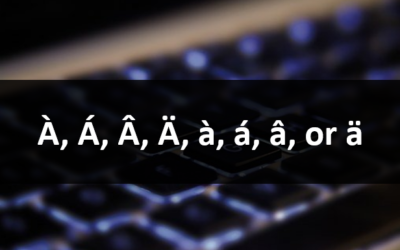Navigating the Microsoft Office Ribbon Using a Keyboard
by Avantix Learning Team | Updated August 26, 2021
Applies to: Microsoft® Word® 2010, 2013, 2016, 2019 and 365 (Windows)
This article is the first in a series of navigating and choosing commands in Microsoft Office using the keyboard.
You have the ability to work in Microsoft Word, Excel and PowerPoint as well as many other programs using just your keyboard. This can be useful for those working with laptops or for any user that has difficulty using a mouse including users with disabilities (particularly those with mobility impairments). For those that use assistive technology such as a screen reader, Microsoft uses a standard called Microsoft Active Accessibility (MSAA) so that users with visual impairments will be able to navigate in the Office programs. You can use these keyboard navigation strategies in Microsoft Word, Excel, PowerPoint, Access, Outlook, Project and Publisher.
Recommended articles: Navigating and Selecting in Dialog Boxes in Word, Excel and PowerPoint Using a Keyboard and Using a Keyboard to Navigate and Select in Task Panes in Word, Excel and PowerPoint
Do you want to learn more about Microsoft Word? Check out our virtual classroom or live classroom Word courses >
Showing or hiding the Ribbon
To show or hide the Ribbon, press Ctrl + F1.
Activating keyboard control in the Ribbon
You can use the Alt key to activate keyboard control in the Ribbon. Key tips will appear on the Ribbon as a small label or badge. You can also press F10 instead of Alt.
Below is an activated Ribbon in Microsoft Excel after the user has pressed Alt:
Choosing commands in the Ribbon using a keyboard
To choose commands in the Ribbon in any of the Microsoft Office programs using badge letters:
- Press Alt. Key Tip labels or badges appear on the Ribbon. One layer of badges appear at a time. Once you choose an option (a letter), then a new set of options appear. The Key Tip badges appear for the active tab.
- Press the appropriate badge letter to activate the desired tab.
- Press the appropriate badge letter to choose the command in the active tab.
- Press Enter to execute the command. If a drop-down menu appears, use the up and down arrows to choose the desired option and then press Enter. A dialog box may appear where you can choose the desired options (more about navigating in dialog boxes in Part 2 of this series).
- If you end up with the Key Tips for the wrong tab, press Escape to display the desired Key Tip badges again.
Below is the Ribbon in Microsoft Word after the user has pressed Alt:
Below is the Ribbon in Microsoft Word after the user has pressed Alt and then N:
Another way to use the keyboard is to move the focus through the tabs and commands. To choose commands on the Ribbon without using badge letters:
- Keep pressing F6 until the focus is on the Ribbon (the Ribbon is active). Key Tip labels will appear in the Ribbon.
- Press the right or left arrow keys until the desired Ribbon tab is active.
- Press Tab to move forward through commands on the active Ribbon tab or Shift + Tab to move backward through commands.
- Press Enter to execute the selected command. If a drop-down menu appears, use the up and down arrows to choose the desired option and then press Enter. A dialog box may appear where you can choose the desired options (more about navigating in dialog boxes in Part 2 of this series).
Inserting a page break in Microsoft Word (example)
For example, to use the keyboard to insert a page break in Microsoft Word:
- Position the cursor where you want to insert a manual page break.
- Press Alt. The Key Tips badges appear on the Ribbon.
- Press P to access the Page Setup tab.
- Press B to access the Break command. A drop-down menu appears with Page Break selected.
- Press Enter.
Getting help
When a command is selected in the Ribbon, press F1 to display the Help dialog. If there is no Help topic associated with the selected command, a general Help topic will be displayed.
Key Tip behaviour
Although the layered approach to Key Tips means that each command in a program has a unique sequence of Key Tips, the same letter may be used on different active tabs.
If a dialog box is open that uses the same letter in a shortcut as a Key Tip, the dialog box "wins" or takes precedence.
In summary, since many users either can't use a mouse or don't use a mouse (such as laptop users using track pads), learning to navigate using the keyboard can make things a lot easier. For some users, the keyboard is their only method to navigate and select.
This article was first published on December 1, 2014 and has been updated for clarity and content.
Next article in this series: Navigating and Selecting in Dialog Boxes Using a Keyboard
Subscribe to get more articles like this one
Did you find this article helpful? If you would like to receive new articles, join our email list.
More resources
3 Strikethrough Shortcuts in Microsoft Word to Cross Out Text
14+ Word Selection Shortcuts to Quickly Select Text
How to Create a Table of Contents in Word (Insert, Format and Update a TOC)
Related courses
Microsoft Word: Intermediate / Advanced
Microsoft Word: Designing Dynamic Word Documents Using Fields
Microsoft Word: Long Documents Master Class
Microsoft Word: Accessible Word Documents
Microsoft Excel: Intermediate / Advanced
Our instructor-led courses are delivered in virtual classroom format or at our downtown Toronto location at 18 King Street East, Suite 1400, Toronto, Ontario, Canada (some in-person classroom courses may also be delivered at an alternate downtown Toronto location). Contact us at info@avantixlearning.ca if you'd like to arrange custom instructor-led virtual classroom or onsite training on a date that's convenient for you.
Copyright 2024 Avantix® Learning
You may also like
How to Insert or Type I with an Accent Mark in Word (Í, í, Ì, ì, Î, î, Ï, or ï)
You can insert or type i with an accent mark in Word using built-in tools or keyboard shortcuts (including Alt code shortcuts). The letter i can be inserted with an accent in both upper or lower case. The following are common accented characters that you can insert or type in Word in upper or lower case: grave (Ì or ì), acute (Í or í), circumflex (Î or î) and umlaut (Ï or ï).
How to Insert or Type A with an Accent Mark in Word (À, Á, Â, Ä, à, á, â, or ä)
You can insert or type a with an accent mark in Word using built-in tools or keyboard shortcuts (including Alt code shortcuts). The letter a can be inserted with an accent in both upper or lower case. The following are common accented characters that you can insert or type in Word in upper or lower case: grave (À or à), acute (Á or á), circumflex (Â or â) and umlaut (Ä or ä).
10 Word Shortcuts to Select Text Using a Keyboard
You can use several shortcuts in Word to select text in your documents using only your keyboard. When you select text, it will typically be highlighted in grey. After you select text, you can cut, copy, or delete the selected text or apply character or paragraph formatting.
Microsoft, the Microsoft logo, Microsoft Office and related Microsoft applications and logos are registered trademarks of Microsoft Corporation in Canada, US and other countries. All other trademarks are the property of the registered owners.
Avantix Learning |18 King Street East, Suite 1400, Toronto, Ontario, Canada M5C 1C4 | Contact us at info@avantixlearning.ca










